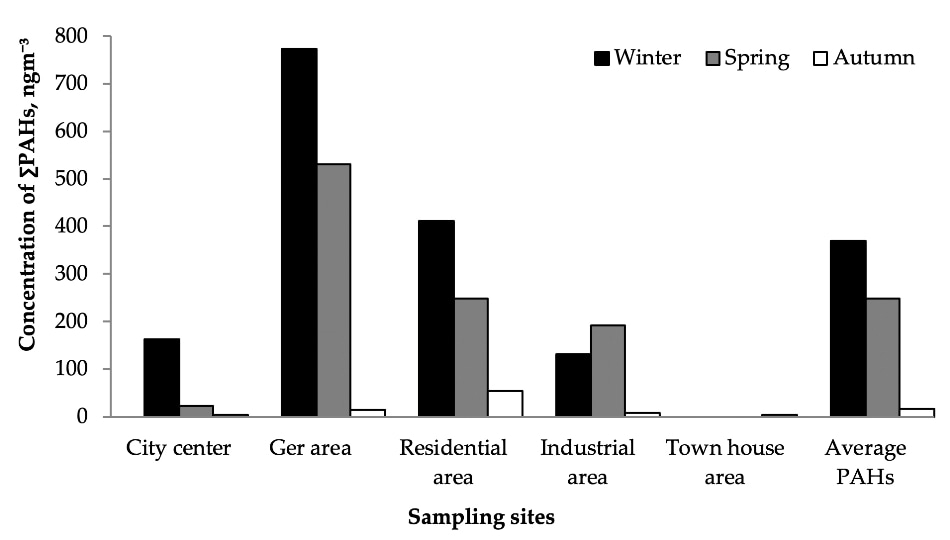Apr 26 2019
Mongol–Japanese scientists from the National University of Mongolia and Kanazawa University carried out the first detailed investigation of organic air contaminants in Ulaanbaartar city.
 Atmospheric concentrations of PAHs in Ulaanbaatar City. (Image credit: Kanazawa University)
Atmospheric concentrations of PAHs in Ulaanbaatar City. (Image credit: Kanazawa University)
The polycyclic aromatic hydrocarbon (PAH) contents of airborne particulates that were determined show to what degree air pollution varies evidently by season and district.
Background
Ulaanbaartar is usually known as the coldest capital city in the world as its temperature can reach -40 °C during winter nights. The severe climate made every family in a ger (a traditional Mongolian house) to consume 3 m3 of wood and >5 tons of raw coal per year. Recently, in Ulaanbaartar, air quality has deteriorated markedly due to population growth and energy demand. Poor air quality leads to serious risks to people’s health in Ulaanbaartar.
The mass concentration of the fine particulate matter, such as PM2.5, is frequently used as an ambient air pollution index. Moreover, PM2.5 concentrations in Ulaanbaartar have often been found to be greater when compared to those in more polluted Asian megacities. The PM2.5 concentration, however, is calculated from the particle mass and not the toxic chemicals absorbed to or contained in the particles.
PAHs are chiefly produced when organic matter is burnt incompletely and pyrolyzed. It is suspected that PAHs are chiefly responsible for many symptoms related to air pollution, for example, asthma, allergy, cancer, and reproductive disorders.
This was the first study of its type to be carried out in Ulaanbaatar. The objective of this study was to identify the sources of the pollutant, assess the health risks caused, and characterize spatiotemporal variations in particulate-bound PAH pollution.
Results
Suspended particle samples from five districts in Ulaanbaatar were collected during the heating and non-heating periods of 2017. The samples were analyzed and the concentrations of 15 PAHs with 2–6 benzene rings were determined.
The total PAH concentration (773 ng m−3 in January 2017) was found to be highest in areas comprising gers and reduced in the following order: residential areas > industrial areas > city center > townhouse areas. The mean PAH concentration in late summer was 23-fold lower compared to the mean concentration in winter and 15-fold lower than the mean concentration in spring.
Particular PAH markers showed a great impact on coal and wood combustion, especially in an area containing gers in summer.
Future Prospects
The study results showed a direct connection between high PAH concentrations in certain districts of Ulaanbaatar and the types of fuel used. They also indicated the problem faced by the city: residents ought to select between heating and improving air quality.
Exposure to polluted air for a long time in winter causes a high lifetime cancer risk, showing that there is an urgent need for marked relief measures to be implemented. The results offer evidence for developing effective, scientifically based strategies to control air pollution.
The study was financially supported by the Higher Engineering Education Development Project; functional material from the Mongolian Natural Minerals for Environmental Engineering, Cementitious and Float Process (No. J11A15), the Ministry of Education, Culture, Sport and Science, the Mongolian Foundation for Science and Technology (SSA_06/2018), the Ministry of Education, Culture, Sport, Science and Technology (MEXT; No. JP17H06458), the Department of Research and Innovation (National University of Mongolia); and a cooperative research program of the Institute of Nature and Environmental Technology, Kanazawa University (Nos. 17039 and 18036).